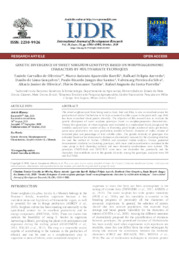Genetic divergence of sweet sorghum genotypes based on morphoagronomic characters by multivariate techniques.
Genetic divergence of sweet sorghum genotypes based on morphoagronomic characters by multivariate techniques.
Author(s): OLIVEIRA, T. C. de; BARELLI, M. A. A.; AZEVEDO, R. F.; GONÇALVES, D. de L.; SANTOS, P. R. J. dos; SILVA, V. P. da; OLIVEIRA, A. J. de; TARDIN, F. D.; PARRELLA, R. A. da C.
Summary: The sweet sorghum apart from being used as food, feed and fiber, is also an excellent source for production of alcohol biofuel due to its high content of soluble sugars in the plant stalk sap), little has been researched about genetic diversity. The objective of this research was to evaluate the genetic divergence of sweet sorghum genotypes based on morphoagronomics characteristics. Twenty-five genotypes of sweet sorghum were evaluated in a randomized blocks design and the variables analyzed were: number of days to flowering; plant height; number of stalks per hectare; green mass production; dry mass production; number of leaves; diameter of stalks; volume of extracted juice and percentage of total soluble solids. The genetic diversity of genotypes was estimated based on the Mahalanobis distance as dissimilarity measure for the clustering structure we used the method of Tocher, UPGMA and canonical variate analysis. Groups generated demonstrated similarity in clustering genotypes, with more similar combinations remained in the same group in both clustering methods and most dissimilar combinations were isolated. The genotypes CMSXS644 and 201027018 were most are dissimilar the genetically and the characters that contribute most to the genetic diversity among the genotypes analyzed were PH and FLOWER.
Publication year: 2020
Types of publication: Journal article
Unit: Embrapa Maize & Sorghum
Keywords: Característica morfoagronômica, Diversidade genética, Sorgo
Observation
Some of Embrapa's publications are published as ePub files. To read them, use or download one of the following free software options to your computer or mobile device. Android: Google Play Books; IOS: iBooks; Windows and Linux: Calibre.
Access other publications
Access the Agricultural Research Database (BDPA) to consult Embrapa's full library collection and records.
Visit Embrapa Bookstore to purchase books and other publications sold by Embrapa.

